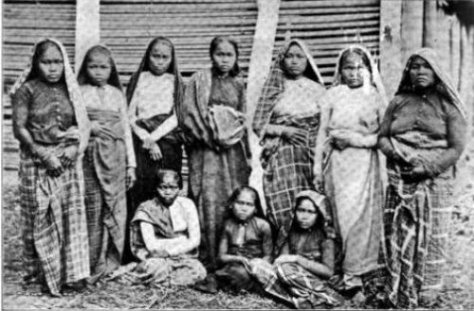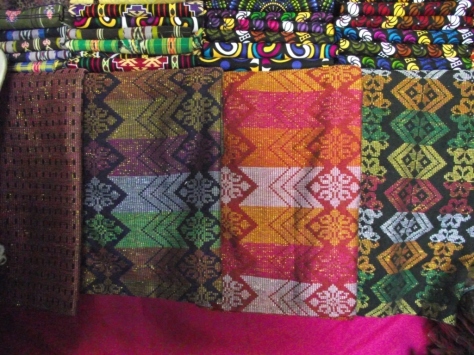
Magola Katemba came from the word “maga ulak a ka temba” which literally means “it’s like the flower of katemba,” meaning color “violet”
When I was a little kid, before going to bed, my mother would tell a story about Magola Katemba. I only heard this from her, so I want to document it and share it with you. (Some names are changed because I can’t recall it).
The story goes like this:
Once upon a time, there lived a beautiful and jolly girl named Magola Katemba. She lived on a hillside with her father, Alimudin. Her mother died when she was a little girl. Her father is a hunter and more often she is left alone in their nipa hut. Aside from being a hunter, her father also had a big rice field. Her father is a very good hunter and a handsome man.
Magola Katemba wanted to have a new mother and she would urge her father to marry. One day, new neighbors moved in. They came from a far away town. They were Babo Kegong and her daughter Kanisan (literally means “so beautiful”).
Magola Katemba was happy when she found out about their new neighbors. She would visit their house and Babo Kegong would comb her hair. Magola Katemba asked her father to marry Babo Kegong. She shared to her father how she wanted to have a mother and a sister.
Soon Alimudin married Babo Kegong. Babo Kegong and her daughter Kanisan were kind at first because Alimudin was getting big money from their rice fields and from selling meats. Babo Kegong was impressed by Alimudin’s fortune.
Soon after, pests attacked their rice field and their harvest was low. Alimudin would haunt for a several weeks to provide for his family. Babo Kegong turned wicked and turned Magola Katemba into a servant, requiring her to work all day long. So the poor girl found everything at home changed for the worse.
Their farm-workers stopped so Magola had to do all the farm works. She would put the rice under the sun to dry and pound them. Babo Kegong would only give her porridge, with dried nasal mucus or a booger and snoot. (ewww, it was an old belief that if one puts booger or snoot in one’s food, that person will be under his/her control; the person will follow everything he/she would say).
Her father would ask her why she’s growing thin and looked pale. Her step-mother would answer that Magola Katemba eats first during meal time and sleeps all the time.
She bore all her hardships with patience and grace, not even complaining to her father, and, in spite of her hard toil, she grew more lovely in face and figure every year.
One day, a one-week fair was organized near their place. Dayunday, games and shows were showcased during the fair. There was also a whale show at the fair. The smart, female whale, Dalabong, was owned by a kind man named Abdul.
One day, Magola Katemba went to the market and watched the show. She soon became attached to the whale and after the fair, Abdul gave Darabong to her. She housed Dalabong to the old well where she used to fetch water.
Magola Katemba would visit Darabong every time she fetches water below the hillside and would feed Dalabong:
“Dadalabong, dadalabong, gemaw ka pan ka nya den su binubog nengka a sinimbulan sa pingat at sinudsakan sa ngug”
Translation: Dalabong, dadalabong, please show up… here’s your porridge sprinkled with booger and mashed with snot.
Dalabong grew bigger and bigger and soon after the whale developed a breast. Dalabong soon had a mammary gland and milk flowed in her breast. Her milked tasted like the breast milk of Magola Katemba’s mother when she was alive.
This time, Dalabong would feed Magola Katemba with her milk. Magola Katemba grew healthy and looked more beautiful. Babong Kegong and Kanisan were amazed. They were intrigued where Magola Katemba got her energy.
One day, they secretly followed Magola Katemba and they saw Dalabong. When they returned home, Babo Kegong pretended that she’s not feeling well and had a morning sickness. She told Alimudin that she might be pregnant. She said that the only food that could make her feel okay is a breasted-whale with milk.
Alimudin was shocked, where in the world would he get a breasted-whale with milk. Babo Kegong said that Magola Katemba has a pet called Dalabong, a breasted whale with milk.
Alimudin asked Magola Katemba to give her pet and have it cooked. Then, Alimudin left to hunt in the forest. She cooked Dalabong and served her favorite pet to her step-mother. Her step-mother and step-sister ate all the fish while she was tending the rice field. They left nothing for Magola Katemba but fish bones.
In her loneliness, she used her imagination to comfort herself. She slept with tears in her cheeks. Then, she dreamed of a fairy that looked like her mother. The fairy said, “Plant the fish bones in eight holes.” Then, she was suddenly awaken by her step-mother’s yell. “There you are, you’re oversleeping again. Go get some water!”
The following morning, Magola Katemba planted the fish bones on top of the hill. Not long after she planted it, a plant sprouted on the eight holes. Eight healthy egg-plants grew on the eight holes with flowing milk that taste like her mother’s breast milk.
Once again, Magola Katemba grew healthy and glowing. Her step-mother and step-sister became suspicious. They followed Magola Katemba and discovered about the egg-plants.
He step-sister pretended she’s sick and told Alimudin that she will not live long if she cannot eat an egg-plant with milk. Alimudin was shocked for he had no idea where to get an egg-plant with milk. Her step-mother said that Magola Katemba had it.
Her father asked her to give her plant to save her step-sister’s life. Magola Katemba sadly gave the plant and cooked it for them. Her father soon left again to hunt in the forest. They gave nothing for Magola Katemba but the peelings and stems.
Magola Katemba cried all night long and the fairy showed again. “Plant the stems and peelings on four holes.” Magola Katemba planted the egg-plant peelings and stems the following morning in a nearby forest.
Few days later, she visited the site and she was amazed to see a golden nipa hut that stood on the four holes where she planted the peels and stems. She entered the house and when she was inside the the house lifted up and disappeared in the air.
Inside the golden and magical nipa hut, there are servants and golden kitchenwares, complete with all furnishings, agong, gandingan, kulintang and other brasswares. Then, she requested the servants to lower the house to the ground so that she can go back home.
She went home and worked as if nothing happened. She washed her step-sister and step-mother’s clothes, tended the rice field, pounded the rice, and plowed the rice field.
One day, the prince named Piolo Pascual, joke! … named “Datu Dangalan” went on a hunting game with his soldiers. The prince unknowingly stood below the invisible nipa hut. Things started to fall from the invisible house; the servants threw them to the prince to drive him away. Agong, brasswares and a golden slipper hit the prince. He was amazed where those things came from. A sharp arrow shot and pierced his feet.
He was aided by his soldiers and brought him to the palace. When they arrived his wound grew bigger and the arrow remained in his feet. No one in the palace could take the arrow from his feet. The quack doctors advised the prince to send people who will look for the owner of the golden slipper. The palace shamans also believed that the owner of the golden slipper is the only person that can remove the arrow on the prince’s feet.
Men from the palace where sent to nearby villages to look for the owner of the golden shoe. A news was also spread all over the place. The prince had it announced that the girl whose foot fitted the golden slipper would become his wife.
Babo Kegon and Kanisan heard about the news and they were eager to help the prince. Kanisan liked the prince very much and she wanted that the shoe will fit on her feet.
The palace men soon arrived at their house. They asked Kanisan to fit the shoe; she tried in vain to win over the prince. But her feet were smaller than the shoe. Her step-mother also tried the shoe but her feet were bigger than the shoe. The men asked if there are other young ladies in the house. Babo Kegong said none.
The men left the house and saw Magola Katemba at the back of their house pounding a rice. The men asked her to try the shoe. Her step-mother said she’s just a servant and her feet wont fit on the shoe. The palace soldier insisted. Magola Katemba tried the shoe and the slipper fitted perfectly. On that very moment, the arrow vanished and the wound of the prince disappeared.
Soon, a wedding at the palace was arranged. Her step-mother and step-sister grew jealous. They tried to look for the magical nipa hut wishing they can get fortune from it. Instead of fortune, they were welcomed by many arrows and step-mother and step-sister died there.
Alimudin returned home after several months of hunting. He learned about what happened and Magola Katemba shared all the things that happened while he was away. His father was so sorry about her hardships. He promised that it will not happen again …. and they lived happily ever after.


















